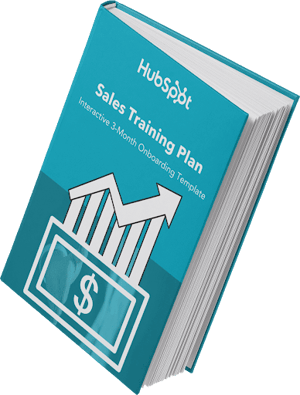Sales training is a time consuming process. In the beginning, it might feel like you’re over-communicating or micro-managing your new team. However, sales people are on the front lines of your business and act as the representatives of your brand. Your sales rep training process should reflect this, and that means you can’t afford to compromise on the content or delivery of your onboarding.
![Download Now: Sales Training & Onboarding Template [Free Tool]](https://no-cache.hubspot.com/cta/default/53/1dc09795-02c8-4fbe-a62b-a1d669dec2c5.png)
The average ramp-up time for sales reps is between six and nine months. With all of this time invested in sales training and onboarding, how do you maximize the return?
In this post, we help you create a comprehensive training and onboarding manual for your sales team. At the end, you'll find examples of sales training manuals to help your reps ramp quickly.
When you're creating a new-hire training plan, remember a few things:
- Keep your training plan personalized because each representative is different.
- Authenticity is the key to building trust. You don’t have to be the stereotypical "loud" salesperson to earn clients.

Download for Free
Sales Manual Examples
Sales manuals are a great way to automate your sales agents’ orientation program.
A sales manual is a guide that contains the background information of your company, the goals you want to achieve, and the selling process. A good sales manual also describes your target client, how to talk to them, the do’s and don'ts of your selling process, etc.
Every sales training manual is different based on what the company is selling as well as the goals and objectives.
For more clarification, here are some sales manual examples that you can use as a guide to write yours.
HubSpot has a very elaborate onboarding process for its sales agents. The entire process takes 90 days.
In the first 30 days, sales agents are introduced to the company's internal organizations, selling systems, solutions, customers, and everything else about the services they offer.
For the next 30 days, the sales agent gets what I'd describe as a "trial process." They start their sales journey applying the concepts, principles, and lessons that they've learned. This is when an agent gets their style through experimentation.
After 60 days, the sales agents are ready to start working officially. At this point, the sales manager sets key performance indicators (KPIs) for the agent and provides them with everything they need to achieve them. On the 90th day, the agent can monitor their progress and see what they can change for better results.
For more details on the 30/60/90 method, download the HubSpot Free Sales Training Manual.
Jibu is a drinking water company with over 154 Franchises across 7 African countries. They've sold over 333 million liters in just 8 years, so they're clearly doing something right.
Jibu has an extensive sales agent training guide like any other successful organizations. Their sales manual template is divided into two sections.
The first part contains the background information of the company. This includes:
- What sets them apart from their competitors
- Who their customers are and why they love Jibu
- Their production technology
- How they settled to their price range
This part allows the sales agents to connect with the company and understand how things run across the organization.
The second part of the sales agent guide has the selling process. Some of the things that the sales agent learns in this part include:
- The difference between marketing and sales
- The different types of Jibu customers
- How to engage with customers
- What to avoid in sales
This part is crucial in ensuring that all the sales agents understand the company's expectations on how they should carry themselves.
Check out the Jibu Sales Training and Development Guide PDF to see all the details.
This guide is ideal for a newbie in the sales department. Badge Sales Training Manual provides a comprehensive guide on all the basics of sales training. It defines sales, gives you the benefits of sales training, and teaches you how to go about it.
In this guide, you'll learn hacks like how to cut the sales training program time by 50%. This will ensure your sales agents are effective and you don't spend months in the training session without getting results. You will also learn how to automate certain tasks and the best tools to use.
The Badger sales manual also teaches you all types of sales marketing methods to ensure you choose the one aligned with your products or services. Check out the Badger Sales Training PDF to learn all the basics in sales.
Trojan is a subsidiary of Hire Quest Direct that has been in the industry since 2002. They help companies looking for workers in any field – most of the workers are temporary, which is very economical for many companies.
Trojan has an intensive sales manual training guide that teaches their sales agents everything they need to know to sell their staffing services.
Their sales manual shares email and call templates their agents can use in all possible scenarios, which makes work easier for the new recruits. The manual also teaches the agents the importance of not over-glamorizing their services to manage the customers' expectations. It also guides an agent on what to do once a customer makes an order and the correct follow-up messages.
Stages of an Onboarding Process
- Pre-week training
- Day-One
- Email and Administrative Preparation
Stage 1: Pre-Week Training
If you want them to come confident and prepared to maximize their first day, consider pre-week training. This gives your sales representatives more information on their roles and what they’ll learn during training.
New sales hires at HubSpot experience “a day in the life” of a HubSpot sales representative before their official first day. From technical setup to call observation and activity shadowing, new representatives get an up-close look at the end goal of their training period.
Stage 2: Day One
About 72% of employees say one-on-one time with their direct manager is the most important part of the onboarding process. It’s crucial that your new hires’ first day sets the right tone for their career in your company. To make sure they feel like they’re being formally introduced to their role, provide them with a direct manager on the first day at work, so they don’t feel that they are being led astray.
Stage 3: Email and Administrative Preparation
To combat the isolating feeling that can come with being new hire, make sure the email account of your new representative is accessible prior to the first day of work. This allows you to send the new hire HR information ahead of time, as well as an agenda for day one. That way, even if your day is packed, they will know where to go and who to meet.
Stage 4: Orientation
Using the first day to orient your company’s new hires broadens the strokes of the company. Take care of HR documentation, set them up with a computer, and introduce them to the company on a high level.
At HubSpot, these are just a few of the things their new hires experience on their first day. They also have lunch with a veteran HubSpotter to learn more about the company and. In addition, new hires also get a chance to ask questions from a senior sf, or someone who’s been around for a while.
You'll also want to introduce them to their 30-60-90 day plan that outlines expectations as they ramp up. Let’s dive into what this plan might look like.
Stage 5: First 30 Days
The first month (30 days) of your representative circles around learning: your company, your customers, your solutions, your internal organization and processes, and their role within it all. Getting them acquainted with these things may include:
Stage 6: Product or Service Training
What will your rep be selling? Whether it’s pool supplies or software, it’s important to train them on how to administer, use, and see the value of your product or service.
HubSpot’s new hires go through extensive product and Inbound Marketing training. They learn how to use HubSpot’s CRM, Marketing, and Sales tools. The hands-on training has them building landing pages, setting up contacts, and presenting “final projects” at the end of their training cycle. The project serves as a benchmark for new hires. Reps get to show off their understanding of HubSpot tools, and managers can gauge new hire progress.
Stage 7: Gaining Understanding of the Market
A successful sale often comes down to BANT: Budget, Authority, Need, and Timing. While determining budget and handling general price objections can be pretty straightforward for an experienced representative, the other three components require familiarity (and perhaps intimacy) with both the buyer and the market:
-
Authority - To establish authority with the prospect, the representative must understand your position in the market: your strengths and weaknesses, as well as those of your competitors.
-
Need - Representative must also develop competency in mapping those strengths and weaknesses to prospect pain points to qualify for (and prove) fit.
-
Timing - Gauging the prospect's timing, knowing customer and sales lifecycles, and developing a nurturing and follow-up process that works with those life cycles are crucial for getting the timing just right.
All of these take experience and training.
Stage 8: First 60 Days
Once the sales representative completes their "information gathering" period, it's time to give them hands-on experience to improve their comfort level and get them into process development and routine.
Job Shadowing
An effective way to get a representative’s feet wet is by pairing them with one of your seasoned team members so they can gain insight in live time. Have the new employee listen to calls, ask questions about workflow, and get a sense of the team’s strategy.
Prospecting and Introductions
The representative should also be given a chance to introduce themselves to points of contact for accounts they’re inheriting and/or do some initial prospecting and outreach to begin filling their pipeline.
Performance Reviews
Be sure to meet with the representatives to provide feedback, encourage good habits, and reinforce performance milestones and goals.
Stage 9: First 90 Days
After 60 days, the representative should be comfortable and autonomous enough to apply their training and start making an impact as their pipeline opens up. Managers should ensure that new reps have everything they need to:
- Establish a schedule that's aggressive but works for them
- Meet with prospects and develop relationships
- Navigate the process, hit KPIs, and crush goals
Stage 10: Post-Training
Once you’re sure your representatives are ready to hit the ground, here are some of the last things you need to do.
Set clear expectations & goals.
Set 30-, 60-, and 90-day goals. Calculate ramp rate based on the average number of months it takes a new salesperson to hit 100% (or close to) of quota. To make this more accurate, segment an average ramp period by experience — for example, it might take the typical veteran salesperson four months to ramp, while a freshly-minted college grad requires nine months.
Establish a new-hire mentor.
A Microsoft study found that employees who are paired with a mentor or “buddy” are more productive in 97% of the cases.
Assign every new salesperson a mentor who’s been in their position for a longer period. Mentees can bounce questions, comments, and new hire growing pains of their mentors. Mentorship provides new hires with perspective, guidance, and advice from someone outside their management team.
At HubSpot, every new hire is paired with a mentor. Beyond the first few weeks, mentors can offer career advice, make important networking connections, and save salespeople from burnout. Pair new hires with mentors, and you’ll set them up for a longer, happier career with your company.
1. Train them on how to use your CRM.
Teach your reps how to use your CRM, and include hands-on, project-based training (like how to enter new contacts, set reminders, and log communication). When appropriate, have them take a CRM certification exam. Most CRMs offer them, and it’s a great way to ensure that new reps understand how to use the tt software.
You can find HubSpot’s free certification courses here.
2. Conduct call reviews.
Sign up new hires for call reviews — and lots of ‘em. It’s good for them to listen to reviews from your top reps and a few from reps who haven’t been part of the team for so long. This allows new hires to learn from a variety of experience levels and gives them access to different types of critique.
3. Provide a sales process overview.
Cover the main stages of the sales process and conversion rate benchmarks (on average, 10% of emails convert to connect calls, 20% of connect calls convert to discover calls, etc.) This tells your new representatives where to prioritize efforts and what kind of numbers they’ll be held to.
4. Train reps on how your company handles prospecting.
How does your company prospect? Share common channels, number of touchpoints, and best practices. Outline how much research representatives should conduct and which details they should look for.
5. Walk the reps through your buyer personas.
In this section of training, describe your ideal customer. If you’re a B2B company, teach your salespeople what a best-fit company looks like and which contacts they should be trying to make at that company. If you’re B2C, describe the types of consumers reps should be targeting. You should also lay out the foundation for how your organization assesses and communicates with decision-makers.
6. Provide a competitive analysis.
Provide an overview of your main competitors then share a competitive analysis that highlights exactly what makes you different. Be honest about where your product/service falls short of the competition and where it outperforms the rest of the market.
7. Have strong reps provide demo training.
Incorporate good and bad examples into demo training and have everyone participate in role-play. Conduct reviews of new hire demos, connect calls, and close conversations. Include common objections that arise during your sales process and let new hires respond to those objections before supplying them with ready-made scripts.
A good rule of thumb is to provide positive feedback first, then move to areas for improvement. Foster this rule in your sales organization to create a team that embraces constructive criticism instead of being afraid or resentful of it.
8. Hold technical training.
Learning to use team or company technology (i.e., phones, video platforms, etc.) can be a tough and undocumented process. Train new hires on how to use your technological resources, and have them showcase their skills during a demo with you. When they can troubleshoot basic issues — like asking prospects to mute their microphones if an echo arises during a presentation — they’re one step closer to being ready for a live call.
9. Practice negotiating and common object handling.
Even experienced representatives need to know how a company approaches the negotiation phase. What are your parameters for discounts and sales? What kind of judgment calls can your representatives make in terms of discounts? And, what is the etiquette for discussing these topics with prospects?
10. Offer onboarding training when applicable.
Will your representatives be in charge of onboarding new clients? Share best practices and responsibilities that accompany this role. If there’s a hand-off to a renewal manager or customer experience representative, make sure both parties understand what that process is as well.
11. Encourage necessary certifications.
At the end of their sales training, hold a certification exam. Have your reps role-play an exploratory call, demo, negotiation, and closing call. This allows you to gauge whether a rep is ready to start representing your company in front of prospective clients.
By the end of training, HubSpot representatives are both certified inbound sales and inbound marketing certified. They’re also certified in giving HubSpot Demos. Certain passing scores must be met and managers are notified if further training is necessary.
12. Create vertical-, role- or territory-specific training.
Make sure each new hire receives relevant supplementary training for role-specific duties. If you’re onboarding a BDR, provide further training on how to qualify prospects by asking the right questions. And, train your reps on specific verticals or territories they’ll be targeting (i.e., when prospecting in the pacific northwest, phone calls convert at a higher rate than emails).
13. Offer leadership/management training.
Everyone should move through basic sales training to understand the goals, values, and customers that your sales organization prioritizes. If you’re bringing in a manager or executive, further training may be required to set them up for success.
Make Your Sales Training Worthwhile
Ramp up for salespeople is tough. But if you do it right, you’ll see a huge ROI on the time and efforts you invest in new hires early on. Don’t skimp here, and you’ll enjoy the benefits of talent retention, high morale, and high-quality sales strategy.
Editor's note: This post was originally published in August 2019 and has been updated for comprehensiveness.





















 Almost every traditional book on sales methodologies has a section on overcoming objections. The techniques proposed often seem to be manipulative and self-serving. They often come across like an attempt to outwit the customer.
Almost every traditional book on sales methodologies has a section on overcoming objections. The techniques proposed often seem to be manipulative and self-serving. They often come across like an attempt to outwit the customer. Bob Apollo
Bob Apollo







![Download Now: Sales Training & Onboarding Template [Free Tool]](https://no-cache.hubspot.com/cta/default/53/1dc09795-02c8-4fbe-a62b-a1d669dec2c5.png)
















